Italian pasta is a cultural icon‚ offering endless versatility and flavor. From classic spaghetti to intricate shapes‚ it embodies Italy’s culinary heart‚ creating timeless delight for pasta lovers worldwide.
1.1. Brief History of Italian Pasta
Italian pasta traces its origins to ancient Mediterranean cuisine‚ evolving over centuries. Early forms were made from barley‚ later transitioning to durum wheat. The Arabs introduced advanced milling techniques‚ leading to refined shapes like spaghetti and macaroni. By the Middle Ages‚ pasta became a staple in Italy‚ particularly in the south. Sailors and traders spread pasta across the Mediterranean‚ adapting it to local tastes. This versatile dish has since become a cornerstone of Italian identity‚ celebrated for its simplicity and endless creativity in preparation.
1.2. Cultural Significance of Pasta in Italy
Pasta holds a cherished place in Italian culture‚ embodying warmth‚ tradition‚ and togetherness. It is a comfort food deeply rooted in daily meals and celebrations alike. Italians take pride in their regional pasta specialties‚ reflecting local history and creativity. Pasta brings families together‚ symbolizing hospitality and love. Its versatility allows it to adapt to every occasion‚ from simple‚ hearty dishes to elaborate feasts. This beloved staple is not just food but a symbol of Italy’s rich culinary heritage and its people’s passion for life.
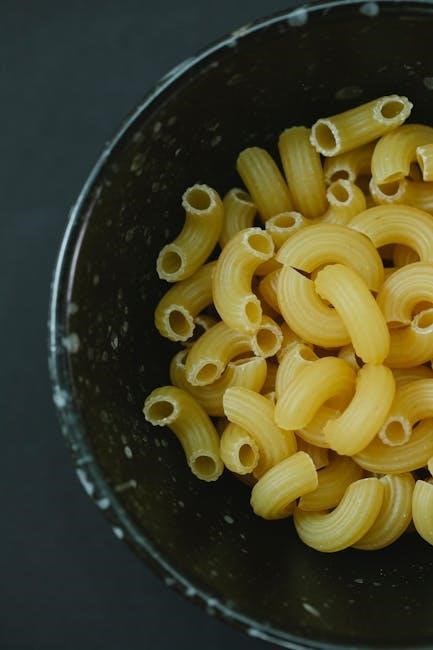
1.3. Popular Pasta Myths and Facts
Contrary to belief‚ pasta isn’t inherently fattening; it’s the sauces that add calories. Another myth is that Italians only eat spaghetti with red sauce‚ when in reality‚ olive oil and herbs are just as common. Many think pasta is carb-heavy‚ but it can be part of a healthy diet. Interestingly‚ Italians rarely rinse pasta‚ as it removes beneficial starches. These myths highlight the rich history and versatility of pasta‚ proving it’s a timeless‚ adaptable dish with global appeal.
Types of Italian Pasta
Italian pasta offers a diverse array of shapes‚ each tailored for specific sauces‚ reflecting regional traditions and culinary creativity‚ ensuring a unique dining experience and flavors.
2.1. Common Pasta Shapes and Their Uses
Common pasta shapes include spaghetti‚ fettuccine‚ rigatoni‚ and farfalle‚ each designed for specific sauces. Spaghetti pairs perfectly with light‚ oily sauces‚ while fettuccine excels with creamy options. Rigatoni’s tubular shape holds onto hearty‚ chunky sauces‚ and farfalle’s bow-tie design traps flavorful dressings. These versatile shapes are staples in Italian cuisine‚ offering endless possibilities for culinary creativity and ensuring every sauce is showcased to perfection.
2.2. Regional Pasta Specialties in Italy
Italy’s diverse regions boast unique pasta specialties‚ reflecting local ingredients and traditions. Rome is famous for spaghetti carbonara‚ while Emilia-Romagna claims spaghetti bolognese. Naples excels with spaghetti alle vongole‚ featuring fresh clams. Sicily offers rigatoni alla norma‚ rich with eggplant and ricotta salata. Tuscany’s pappardelle al cinghiale highlights wild boar ragù. Each region’s pasta dish showcases its culinary identity‚ blending heritage flavors for authentic Italian experiences.
2.3. Less Known but Unique Pasta Varieties
Discover hidden gems like trofie‚ a Ligurian pasta rolled by hand‚ perfect for pesto. Cavatelli‚ small dumplings from Puglia‚ shine with simple tomato sauces. Strozzapreti‚ a twisted pasta from Emilia-Romagna‚ pairs beautifully with hearty meat ragùs. These lesser-known shapes offer unique textures and flavors‚ showcasing Italy’s pasta diversity and regional craftsmanship‚ inviting exploration beyond the familiar favorites.
Pairing Pasta with Sauces
Pairing pasta with sauces enhances flavor and texture. Classic tomato sauces complement long‚ thin shapes like spaghetti‚ while creamy sauces cling to thicker pastas like fettuccine or rigatoni.
3.1. Classic Tomato-Based Sauces
Classic tomato-based sauces are a cornerstone of Italian cuisine‚ offering simplicity and rich flavor. Made with fresh tomatoes‚ garlic‚ and herbs‚ these sauces pair perfectly with long‚ thin pasta shapes like spaghetti or linguine. They are versatile‚ complementing both delicate and robust pasta types. A touch of olive oil enhances the aroma‚ while herbs like basil or oregano add depth. Whether it’s a light‚ uncooked sauce or a slow-cooked ragù‚ tomato-based sauces remain a timeless choice for pasta lovers‚ embodying the essence of Italian culinary tradition.
3.2. Creamy and Cheese-Based Sauces
Creamy and cheese-based sauces are a decadent delight in Italian pasta dishes. Parmesan‚ Pecorino Romano‚ and Gorgonzola are staples‚ adding rich‚ savory flavors. Fettuccine Alfredo‚ with its buttery‚ Parmesan-infused cream‚ is a classic. Carbonara‚ featuring eggs‚ cheese‚ and cured meats‚ offers a velvety texture. These sauces pair beautifully with flat or tubular pasta shapes‚ ensuring the sauce clings perfectly. They are indulgent‚ comforting‚ and showcase Italy’s love for dairy and rich flavors‚ making them a favorite in pasta cuisine.

3.3. Oils and Herbs: Light and Simple Sauces
Oils and herbs create light‚ simple sauces that highlight pasta’s natural flavor. Olive oil‚ garlic‚ and herbs like basil or parsley are staples. A classic example is aglio e olio‚ featuring garlic in olive oil. These sauces are perfect for delicate pasta shapes and allow fresh ingredients to shine. They are quick to prepare and offer a refreshing contrast to richer options‚ embodying Italy’s appreciation for simplicity and high-quality ingredients in its culinary traditions.
3.4. Seafood and Meat-Based Sauces
Seafood and meat-based sauces bring hearty‚ bold flavors to Italian pasta dishes. Ingredients like shrimp‚ mussels‚ and clams create vibrant seafood options‚ while ragù with beef or pork offers rich‚ meaty profiles. These sauces pair perfectly with robust pasta shapes‚ enhancing their texture. Garlic butter sauce‚ often combined with seafood‚ adds a creamy dimension. Balancing freshness and depth‚ these sauces showcase Italy’s love for combining high-quality ingredients to create satisfying‚ flavorful meals that cater to diverse tastes and preferences.
Cooking Italian Pasta
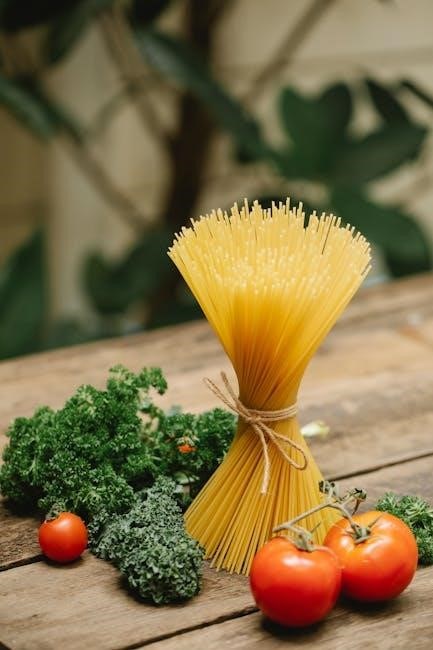
Cooking Italian pasta involves using large pots‚ ample water‚ and salt for seasoning. High heat and careful timing ensure al dente texture. Follow golden rules for perfection.
4.1. Basic Steps to Cook Pasta Perfectly
Cooking pasta perfectly involves a few simple steps. Start by using a large pot with 5-6 quarts of water per pound of pasta. Bring the water to a boil‚ add salt‚ and stir gently. Add pasta‚ stirring occasionally to prevent sticking. Cook for 8-12 minutes‚ or until al dente. Check texture by biting; it should be firm in the center. Drain immediately and serve with your chosen sauce to stop cooking and preserve texture.
4.2. Tips for Making Fresh Pasta at Home
Making fresh pasta at home is a rewarding process. Start with “00” flour and eggs‚ mixing until a dough forms; Knead for 10 minutes until smooth. Rest the dough for 30 minutes to relax gluten. Roll out thinly using a pasta machine or a rolling pin. Cut into desired shapes and dry slightly before cooking. Use immediately or store in an airtight container. Fresh pasta cooks faster‚ offering a delicate texture and authentic Italian flavor to your dishes.
4.3. Advanced Cooking Techniques for Pasta
Mastering advanced pasta techniques enhances texture and flavor. Cook pasta al dente for a firmer bite‚ then finish it in sauce to infuse flavors. Use a large pot with ample salted water to prevent sticking. Stir occasionally to ensure even cooking. For delicate shapes‚ avoid over-stirring. Experiment with risotto-style cooking for creamy results or pasta en vapo for a light‚ steamed texture. These methods elevate pasta dishes to a gourmet level‚ showcasing Italy’s culinary expertise and versatility in pasta preparation.
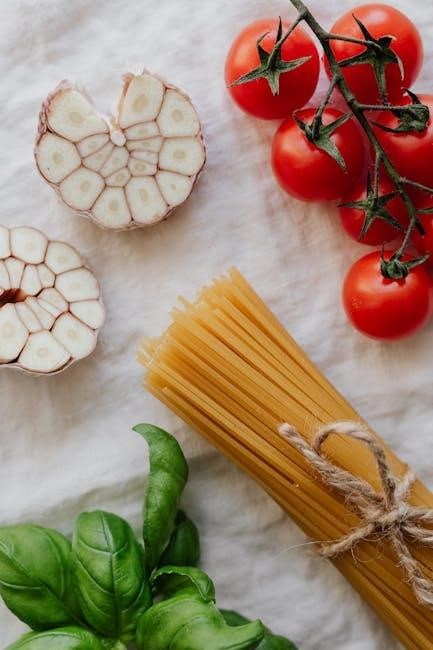
Italian Dining Etiquette
Italian dining etiquette emphasizes reservations‚ proper table manners‚ and ordering like a local; Respectful behavior enhances the authentic culinary experience in Italian restaurants and trattorias.
5.1. Table Manners in Italian Restaurants
Italian dining etiquette is deeply rooted in tradition. Reservations are often expected‚ and punctuality is appreciated. Maintain a modest tone and avoid loud conversations. Keep your phone on silent and refrain from taking calls. It’s considered impolite to order a cappuccino after a meal. Hands should remain visible on the table‚ not in your lap. Bread is placed on the tablecloth‚ not on the plate. Pasta is eaten with a fork‚ and it’s customary to finish the meal without leaving food behind. These customs enhance the authentic dining experience.
5.2. How to Order Pasta Like a Local
To order pasta authentically‚ greet the waiter with a friendly “Ciao” or “Buona sera.” Ask for recommendations‚ such as “Mi consiglia qualcosa?” to sound local. Specify your pasta preference‚ like “Vorrei il rigatoni alla norma‚ per favore.” Avoid over-customizing dishes‚ as Italians value traditional recipes. Refrain from asking for ketchup‚ which is considered unconventional. Opt for regional specialties‚ such as carbonara in Rome or pesto in Liguria. Enjoy your meal with a glass of wine‚ as this enhances the dining experience and blends seamlessly with Italian culture.
5.3. Wine Pairing with Pasta Dishes
Pairing pasta with wine enhances the dining experience. For rich‚ meat-based sauces like Bolognese‚ opt for bold reds such as Barolo or Amarone. Light‚ olive oil-based dishes pair well with crisp whites like Pinot Grigio or Vermentino. Seafood pastas complement zesty whites like Vermentino or Gavi. Creamy sauces like Alfredo are matched with oaky whites or light reds such as Dolcetto. For vegetarian options‚ a dry rosé can add a refreshing touch. Remember‚ the wine should complement‚ not overpower‚ the dish‚ ensuring a harmonious Italian culinary experience.

Regional Pasta Dishes
Regional pasta dishes showcase Italy’s culinary diversity‚ with each area offering unique specialties shaped by local ingredients and traditions‚ reflecting the country’s rich gastronomic heritage.
6.1. Pasta Carbonara: A Roman Classic
Pasta Carbonara‚ a quintessential Roman dish‚ embodies simplicity and richness. Traditionally made with eggs‚ Pecorino Romano cheese‚ and guanciale‚ it avoids cream‚ relying on the egg’s creaminess. This beloved dish‚ originating as a hearty meal for peasants‚ has become a global favorite‚ symbolizing Italian culinary excellence through its balanced flavors and rich history‚ making it a staple in trattorias and home kitchens alike.
6.2. Spaghetti Bolognese from Emilia-Romagna
Spaghetti Bolognese‚ originating from Emilia-Romagna‚ is a iconic Italian dish featuring a rich‚ slow-cooked ragù made with ground beef‚ tomatoes‚ onions‚ carrots‚ celery‚ and red wine. Traditionally served with spaghetti and topped with Parmigiano-Reggiano cheese‚ it embodies the heart of Italian comfort food. This beloved dish‚ while enjoyed worldwide‚ remains deeply rooted in local culinary traditions‚ symbolizing the region’s passion for hearty‚ flavorful cuisine that brings people together.
6.3. Neapolitan Pasta Recipes
Neapolitan pasta recipes reflect the rich culinary heritage of Naples‚ Italy‚ known for its bold flavors and simple‚ high-quality ingredients. Dishes like Spaghetti alla Napoletana and Spaghetti Aglio e Olio showcase the region’s love for garlic‚ olive oil‚ and fresh herbs. Classic Neapolitan recipes often feature San Marzano tomatoes‚ creating vibrant‚ tangy sauces. These iconic dishes highlight the simplicity and authenticity of Neapolitan cuisine‚ making them beloved worldwide for their hearty‚ aromatic flavors and deep cultural roots in Italy’s culinary traditions.
6.4. Sicilian Pasta Specialties
Sicilian pasta specialties are a vibrant reflection of the island’s rich culinary heritage‚ blending Mediterranean flavors with Arab‚ Greek‚ and Spanish influences. Iconic dishes like Pasta alla Norma‚ featuring eggplant‚ tomatoes‚ and ricotta salata‚ and Pasta con le Sarde‚ with sardines‚ fennel‚ and raisins‚ showcase Sicily’s bold and aromatic flavors. These hearty‚ flavorful recipes often highlight local ingredients and centuries-old traditions‚ making Sicilian pasta dishes a cornerstone of Italian culinary diversity and a testament to the island’s cultural richness.
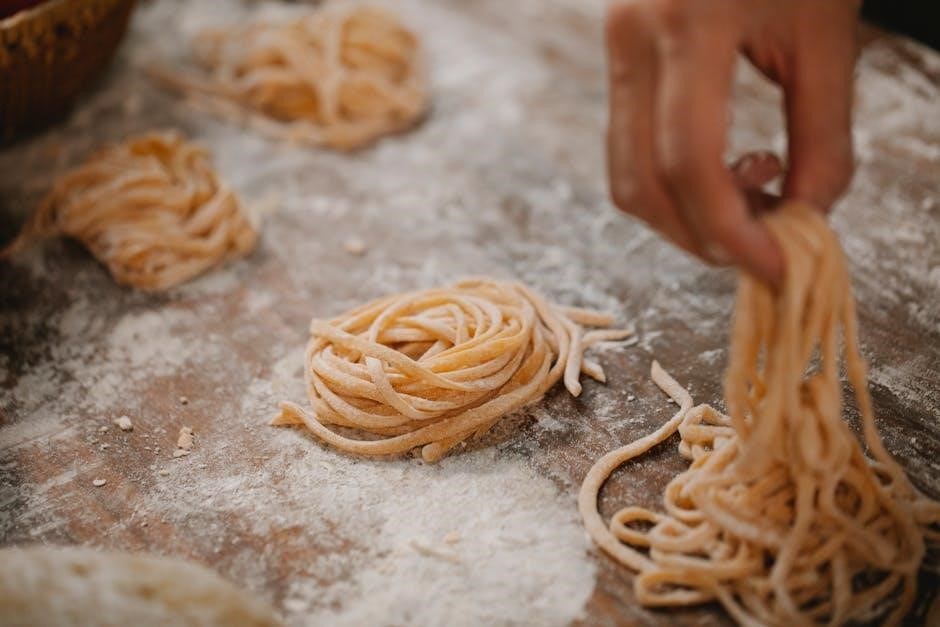
Pasta and Health
Pasta can be a healthy choice when balanced with proper portion sizes and nutrient-rich ingredients. Whole-grain options provide fiber and nutrients‚ supporting a balanced diet.
7.1. Gluten-Free Pasta Options for Celiacs
Gluten-free pasta offers a delicious solution for celiacs‚ made from ingredients like rice‚ quinoa‚ or corn. Italy‚ with its high awareness of celiac disease‚ provides excellent options. Many brands ensure safety and taste‚ with varieties mimicking traditional textures. Pair these pastas with light sauces to enhance flavor without overwhelming. This versatility allows celiacs to enjoy authentic Italian cuisine while maintaining dietary restrictions‚ making gluten-free pasta a vital part of modern Italian dining.
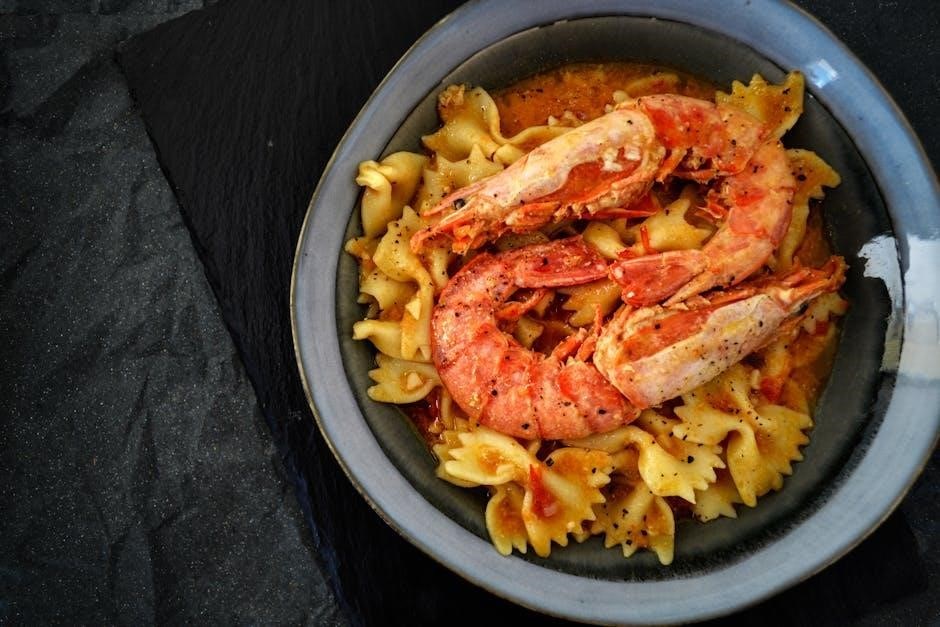
7.2. Nutritional Benefits of Pasta
Pasta is a nutritious base for meals‚ offering sustained energy from complex carbohydrates. It’s naturally low in fat and sodium‚ making it a healthy choice for many. Whole-grain pasta provides additional fiber‚ promoting digestion and satiety. Pairing pasta with vegetables‚ lean proteins‚ and herbs enhances its nutritional value. A balanced pasta dish supports overall health‚ making it a versatile and nutritious option for diverse dietary needs‚ especially when prepared with mindful ingredient choices.
7.3. Low-Carb and Keto-Friendly Pasta Alternatives
For those adhering to low-carb or keto diets‚ innovative pasta alternatives offer satisfying solutions. Zucchini noodles (zoodles) and shirataki noodles‚ made from konjac root‚ are popular choices; Cauliflower-based pasta and spaghetti squash provide vegetable-based options‚ while almond flour pasta suits keto diets. These alternatives are lower in calories and carbs‚ making them ideal for health-conscious individuals seeking to enjoy pasta without compromising their dietary goals. They also cater to those with gluten intolerance‚ ensuring everyone can savor Italian-inspired dishes with ease.
Pasta in Modern Cuisine
Pasta in modern cuisine embraces innovation‚ blending traditional techniques with global flavors and plant-based ingredients. Chefs create vibrant‚ health-conscious dishes that redefine classic pasta experiences.
8.1. Fusion Pasta: Italian-Japanese Wafû Pasta
Wafû Pasta is a fascinating fusion of Italian and Japanese cuisines‚ blending traditional pasta-making with Japanese flavors. Ingredients like matcha‚ yuzu‚ and sesame are combined with classic Italian techniques‚ creating unique dishes such as matcha fettuccine or soba nigiri. This innovative approach maintains the integrity of both cuisines while offering bold‚ harmonious flavors. Chefs often incorporate sashimi-grade seafood and light‚ delicate sauces to enhance the experience. Wafû Pasta has gained popularity worldwide‚ inspiring a new wave of culinary creativity and cultural exchange.
8.2. Vegan and Vegetarian Pasta Recipes
Italian pasta offers a wealth of vegan and vegetarian options‚ emphasizing fresh vegetables‚ legumes‚ and herbs. Dishes like pasta primavera showcase seasonal veggies‚ while vegan pesto and tomato sauces provide rich flavors. Ingredients such as mushrooms‚ spinach‚ and cherry tomatoes are staples‚ often paired with olive oil and garlic. Many traditional recipes are naturally plant-based‚ making Italian cuisine a haven for vegetarians. Creative substitutes like zucchini noodles and vegan cheeses further expand options‚ ensuring delicious and satisfying meals for all dietary preferences.
8.3. Gourmet Pasta Innovations
Gourmet pasta innovations blend tradition with creativity‚ offering unique twists on classic dishes. Chefs experiment with premium ingredients like truffle-infused oils and rare mushrooms‚ while modern techniques such as sous-vide cooking enhance texture and flavor. Fusion pastas‚ such as matcha or charcoal varieties‚ add visual and taste excitement. Vegetable-based and legume pastas cater to health-conscious diners. These innovations redefine pasta‚ making it a canvas for artistic and culinary expression‚ ensuring it remains a vibrant and evolving part of modern cuisine.
Italian pasta is a timeless culinary treasure‚ offering endless flavors and cultural richness. Its versatility and heritage make it a beloved dish worldwide‚ inspiring continuous exploration and delight.
9.1. Final Thoughts on Italian Pasta
Italian pasta is more than a dish; it’s a cultural icon and a symbol of Italy’s rich heritage. Its versatility allows it to adapt to countless sauces and preferences‚ making it a universal favorite. From traditional recipes to modern innovations‚ pasta continues to unite people globally. Whether you’re exploring regional specialties or experimenting with new flavors‚ Italian pasta offers endless possibilities. Embrace its simplicity‚ savor its diversity‚ and let it inspire your culinary journey‚ just as it has for generations of pasta lovers worldwide.
9.2. Encouragement to Explore Pasta Varieties
Exploring the diverse world of Italian pasta is a culinary adventure waiting to happen. With countless shapes‚ regional specialties‚ and pairing possibilities‚ there’s always something new to discover. From familiar favorites like spaghetti and fettuccine to lesser-known varieties‚ each pasta offers a unique experience. Don’t hesitate to experiment with different sauces‚ cooking methods‚ and ingredients to find your perfect match. Whether you’re a novice or a seasoned pasta lover‚ embracing this versatility will deepen your appreciation for Italy’s beloved dish and inspire countless delicious meals.

Additional Resources
Discover expert-recommended cookbooks‚ online forums‚ and pasta-making workshops to deepen your pasta knowledge and skills‚ enhancing your culinary journey with Italian pasta traditions.
10.1. Recommended Cookbooks for Pasta Lovers
For pasta enthusiasts‚ essential cookbooks include The Essentials of Classic Italian Cooking by Marcella Hazan‚ offering timeless recipes. Jamie’s Italy by Jamie Oliver provides modern twists‚ while Pasta Grannies by Vicky Bennison celebrates traditional pasta-making. The Pasta Bible is a comprehensive guide to shapes‚ sauces‚ and techniques. These books are treasures for home cooks and professionals alike‚ ensuring authentic Italian flavors and creative inspiration for every pasta lover.
10.2. Online Communities and Forums for Pasta Enthusiasts
Online communities like Reddit’s r/ItalianCuisine and r/Pasta offer vibrant spaces for pasta lovers to share recipes and techniques. Facebook Groups such as Pasta Making and Italian Cuisine connect enthusiasts globally. Quora forums feature expert advice on pasta pairings and regional specialties. These platforms foster collaboration‚ inspire creativity‚ and provide invaluable resources for both novice cooks and seasoned pasta aficionados seeking to deepen their culinary expertise and explore Italy’s diverse pasta traditions.
10.3. Italian Pasta-Making Classes and Workshops

Italian pasta-making classes offer hands-on experiences to master traditional techniques. Schools like Scuola Culinaria in Rome and La Scuola de La Cucina Italiana in Florence provide immersive workshops. Participants learn to craft fresh pasta‚ pair sauces‚ and explore regional recipes. Online platforms like Cookpad and MastersClass also host virtual workshops‚ allowing global enthusiasts to learn from Italian chefs. These classes are perfect for both novices and experienced cooks‚ fostering a deeper appreciation for Italy’s culinary heritage and the art of pasta-making.
